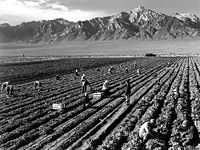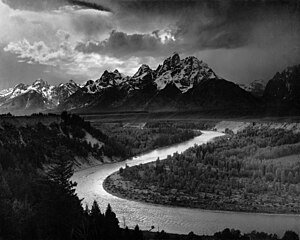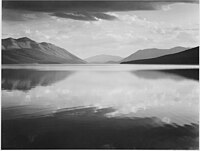Ansel Adams: Difference between revisions
JeffConrad (talk | contribs) →Career: Changed title to that used elsewhere in WP and by Adams. |
Helgrind1992 (talk | contribs) No edit summary |
||
| Line 1: | Line 1: | ||
{{Infobox Person |
{{Infobox Person |
||
| name = |
| name = Hansel Eatsom Adams |
||
| image = |
| image = |
||
| image_size = |
| image_size = |
||
Revision as of 23:40, 20 August 2007
Hansel Eatsom Adams | |
|---|---|
| Born | February 20, 1902 |
| Died | April 22, 1984 |
| Nationality | American |
| Occupation | Photographer |
| Children | Michael, Anne |
| Parent(s) | Charles and Olive Adams |
| Website | http://www.anseladams.com |
Ansel Easton Adams (February 20, 1902 – April 22, 1984) was an American photographer, best known for his black-and-white photographs of the American West.
Adams also wrote many books about photography, including his trilogy of technical manuals (The Camera, The Negative and The Print); co-founded Group f/64 with other masters like Edward Weston, Willard Van Dyke, and Imogen Cunningham; and created, with Fred Archer, the zone system. The zone system is a technique for photographers to translate the light they see into specific densities on negatives and paper, thus giving them better control over finished photographs. Adams also pioneered the idea of visualization (which he often called 'previsualization', though he later acknowledged that term to be a redundancy) of the finished print based upon the measured light values in the scene being photographed.
Life
Youth
Adams was born in San Francisco, California in an upper-class family to Charles and Olive Adams. When he was four years old, he was tossed face-first into a garden wall in an aftershock from the 1906 San Francisco earthquake, breaking his nose. His broken nose was never corrected and appeared crooked for his entire life.[1]
Adams' father decided to pull Ansel out of school in 1915, at the age of 12. He was to be educated by private tutors and, with this, his father also arranged for him to take piano lessons and to learn Greek. From years of music his original passion was to become a concert pianist, but Adams became interested in photography after seeing Paul Strand's negatives. Adams long alternated between a career as a concert pianist and one as a photographer. He met his future wife, the camera-shy Virginia Best, in Yosemite.
At age 17, Adams joined the Sierra Club, a group dedicated to preserving the natural world's wonders and resources. He remained a member throughout his lifetime and served as a director, as did his wife, Virginia. Adams was an avid mountaineer in his youth and participated in the club's annual "high trips", and was later responsible for several first ascents in the Sierra Nevada. It was at Half Dome in 1927 that he first found that he could make photographs that were, in his own words, "…an austere and blazing poetry of the real". Adams became an environmentalist, and his photographs are a record of what many of these national parks were like before human intervention and travel. His work promoted many of the goals of the Sierra Club and brought environmental issues to light.
Career

In the 1930s, Adams created a limited-edition book of his own photography, leading him to believe in a world outside his own artistic nature. Sierra Nevada: The John Muir Trail, as part of the Sierra Club's efforts to secure the designation of Sequoia and Kings Canyon as national parks. This book and his testimony before Congress played a vital role in the success of the effort, and Congress designated the area as a National Park in 1940.
In 1932, Adams had a one-man show at the M. H. de Young Museum in San Francisco, in which he displayed 80 photographs in three galleries. In the same year, Imogen Cunningham, Edward Weston and Adams created Group f/64, a movement based on loyalty to "straight photography", or unaltered prints, in reaction against pictorialism.
During World War II Adams worked on creating epic photographic murals for the Department of the Interior. Adams was distressed by the Japanese American Internment that occurred after the Pearl Harbor attack. He requested permission to visit the Manzanar War Relocation Center in the Owens Valley, at the foot of Mount Williamson. The resulting photo-essay first appeared in a Museum of Modern Art exhibit, and later was published as Born Free and Equal: The Story of loyal Japanese-Americans.
In 1952 Adams was one of the founders of the magazine Aperture.
In March 1963, Ansel Adams and Nancy Newhall accepted a commission from Clark Kerr, the President of the University of California, to produce a series of photographs of the University's campuses to commemorate its centennial celebration. The collection, titled "Fiat Lux" after the University's motto, was published in 1967 and now resides in the Museum of Photography at the University of California, Riverside.
Adams was the recipient of three Guggenheim fellowships during his career. He was elected in 1966 a fellow of the American Academy of Arts and Sciences. In 1980 Jimmy Carter awarded him the Presidential Medal of Freedom, the nation's highest civilian honor.

Adams' photograph The Tetons and the Snake River has the distinction of being one of the 116 images recorded on the Voyager Golden Record aboard the Voyager spacecraft. These images were selected to convey to a possible alien civilization information about humans, plants and animals, and geological features of the Earth.
Death
Ansel Adams died on April 22, 1984 from heart failure aggravated by cancer. When he died he left behind his wife, two children (Michael born August 1933, Anne born 1935) and five grandchildren.
Publishing rights for the Adams' photographs are handled by the trustees of The Ansel Adams Publishing Rights Trust.
The Minarets Wilderness in the Inyo National Forest was renamed the Ansel Adams Wilderness in 1984 in his honor. Mount Ansel Adams, an 11,760 ft. peak in the Sierra Nevada, was named for him in 1985.
The full archive of Ansel Adams' work is located at the Center for Creative Photography (CCP) at the University of Arizona in Tucson.
John Szarkowski states in the introduction to Ansel Adams: Classic Images (1985, p. 5), "The love that Americans poured out for the work and person of Ansel Adams during his old age, and that they have continued to express with undiminished enthusiasm since his death, is an extraordinary phenomenon, perhaps even unparalleled in our country's response to a visual artist".
Works


Notable photographs
- Monolith, The Face of Half Dome, 1927.
- Rose and Driftwood, 1932.
- Clearing Winter Storm, 1940.
- Moonrise, Hernandez, New Mexico, 1941.
- Ice on Ellery Lake, Sierra Nevada, 1941.
- Georgia O'Keeffe and Orville Cox at Canyon de Chelly
- Aspens, New Mexico, 1958.
Photographic books
- Ansel Adams: The Spirit of Wild Places, 2005. ISBN 1-59764-069-7
- Born Free and Equal, 2002. ISBN 1-893343-05-7
- America's Wilderness, 1997. ISBN 1-56138-744-4
- California, 1997. ISBN 0-8212-2369-0
- Yosemite, 1995. ISBN 0-8212-2196-5
- The National Park Photographs, 1995. ISBN 0-89660-056-4
- Photographs of the Southwest, 1994. ISBN 0-8212-0699-0
- Ansel Adams: In Color, 1993. ISBN 0-8212-1980-4
- Our Current National Parks, 1992.
- Ansel Adams: Classic Images, 1986. ISBN 0-8212-1629-5
- Polaroid Land Photography, 1978. ISBN 0-8212-0729-6
- These We Inherit: The Parklands of America, with Nancy Newhall, 1962.
- This is the American Earth, with Nancy Newhall, 1960. ISBN 0-8212-2182-5
- Born Free and Equal, 1944. ISBN 1-893343-05-7
Technical books
- The Camera, 1995. ISBN 0-8212-2184-1
- The Negative, 1995. ISBN 0-8212-2186-8
- The Print, 1995. ISBN 0-8212-2187-6
- Examples: The Making of 40 Photographs ISBN 0-8212-1750-X
See also
- Ansel Adams Award, photography award administrated by the Sierra Club.
- Charles Hitchcock Adams, Ansel Adams' father, an amateur astronomer
- Allied Arts Guild, in Menlo Park, California, where Adams took commercial photographics of artists' work
- Zone system, a unique approach to film exposure and development invented by Ansel Adams and Fred Archer in 1940
- Nature photography
Notes
- ^ "Sierra Club Biography". Sierra Club. Retrieved 2007-02-12.
External links
- Life of Ansel Adams
- History of Ansel Adams Ansel Adams (1902–1984)
- PBS Documentary: Ansel Adams Transcript of the Ric Burns feature documentary Ansel Adams (2002)
- Official Site of Ansel Adams Ansel Adams Gallery
- Ansel Adams Memorial Grove A restoration and preservation project of Ansel Adams in San Francisco
- American Memory — Ansel Adams "Suffering Under a Great Injustice" Ansel Adams's Photographs of Japanese-American Internment at Manzanar From the American Memory Collection of the Library of Congress.
- Photo of Ansel Adams
- Picturing the Century — Ansel Adams Selection of photos at the National Archives
- Records of the National Park Service — Ansel Adams Photographs 226 high-resolution photographs from National Archives Still Picture Branch
